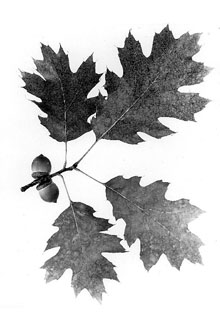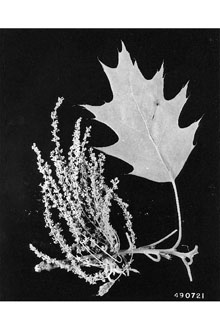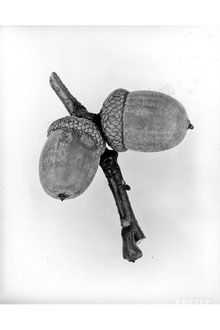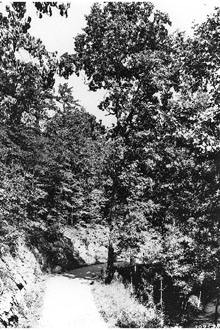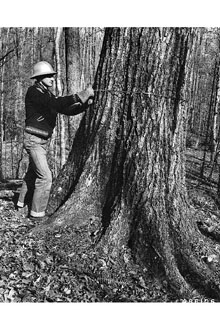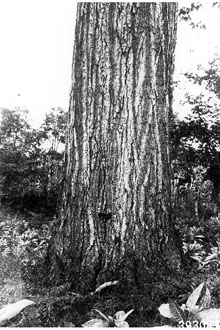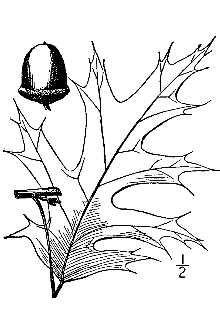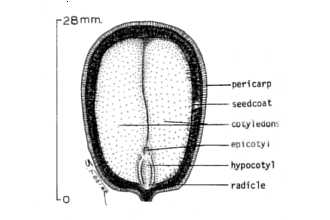Northern Red Oak
Scientific Name: Quercus rubra L.
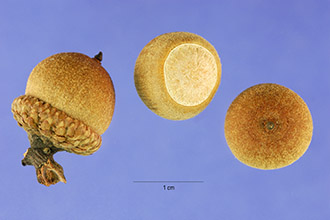
| General Information | |
|---|---|
| Usda Symbol | QURU |
| Group | Dicot |
| Life Cycle | Perennial |
| Growth Habits | Tree |
| Native Locations | QURU |
Plant Guide
Alternate Names
Red oak, common red oak, eastern red oak, mountain red oak, gray oak
Uses
Industry: Northern red oak is an important source of hardwood lumber. The wood is close-grained, heavy, and hard; it machines well and accepts a variety of finishes. It is used for furniture, veneer, interior finishing, cabinets, paneling, and flooring as well as for agricultural implements, posts, and railway ties. Wildlife: Northern red oak provides good cover and nesting sites (including cavities) for a wide variety of birds and mammals. Deer, elk, moose, and rabbits commonly browse leaves and young seedlings and the acorns are eaten by a wide variety of large and small mammals and birds. Ethnobotanic: The acorns of red oak (and other oak species) were an important food source for Native Americans. To remove bitter tannins, they were boiled, leached with ashes, soaked for days in water, or buried over winter. Some tribes used red oak bark as a medicine for heart troubles and bronchial infections or as an astringent, disinfectant, and cleanser. Conservation: Northern red oak is commonly planted as a landscape tree in eastern North America and Europe -- used as a shade tree on lawns, parks, campuses, golf courses, etc, where space is sufficient. It is fast growing, easy to transplant, tolerant of urban conditions (including dry and acidic soil and air pollution), the abundant nuts attract wildlife, and the leaves develop a brick-red fall color. It has been used in various rehabilitation projects, including revegetation of coal mine spoils in states of the east central United States (Ohio, Indiana, Illinois, Kentucky, and Pennsylvania). © Mike Hogan Trees of Alabama and the Southeast Auburn University
Status
Please consult the PLANTS Web site and your State Department of Natural Resources for this plant’s current status, such as, state noxious status and wetland indicator values.
Description
General: Beech Family (Fagaceae). Native trees often reaching 20–30 m tall, less commonly up to 50 m; bark dark gray or black, shallowly furrowed into broad hard scaly ridges, inner bark reddish to pink; generally developing a strong taproot and network of deep, spreading laterals. Leaves are deciduous, alternate, elliptic, 10–25 cm long and 8–15 cm wide, divided less than halfway to midvein into 7–11 shallow wavy lobes with a few irregular bristle-tipped teeth, sinuses usually extending less than 1/2 distance to midrib, glabrous and dull green above, light dull green below with tufts of hairs in vein angles. Male and female flowers are borne in separate catkins on the same tree (the species monoecious), the staminate catkins in leaf axils of the previous year's growth, the pistillate in 2–many-flowered spikes in the leaf axils. Acorns maturing in the second year, about 15–30 cm long, with a broad usually shallow cup, borne singly or in clusters of 2–5. The common name is in reference to the red fall foliage color, red petioles, and reddish interior wood. This is a different species from “southern red oak” (Q. falcata). Northern red oak is a member of the red oak subgroup (subg. Erythrobalanus = sect. Lobatae). It hybridizes with related species, including scarlet oak (Q. coccinea), northern pin oak (Q. ellipsoidalis), shingle oak (Q. imbricata), scrub oak (Q. ilicifolia), blackjack oak (Q. marilandica), swamp oak (Q. palustris), willow oak (Q. phellos), Shumard oak (Q. shumardii), and black oak (Q. velutina). Variation within the species: There are different interpretations of variation patterns among trees of northern red oak. A single species without formally variants is sometimes recognized, or two varieties may be recognized. Quercus rubra var. ambigua (A. Gray) Fernald SY= Q. borealis Michx. f. SY= Q. rubra var. borealis (Michx. f.) Farw. Quercus rubra var. rubra SY= Q. maxima (Marsh.) Ashe SY= Q. borealis var. maxima (Marsh.) Ashe Var. rubra has a shallow cup, to 3 cm wide, enclosing 1/4–1/5 of the nut. Var. ambigua has a deeper cup, to 2 cm wide, enclosing 1/3 of the nut. McDougal and Parks (1984, 1986) found evidence of correspondence between morphological types and flavonoid chemotypes but the evolutionary status and geographic distribution of these have not been worked out in detail.
Distribution
Northern red oak is widely distributed throughout much of the eastern United States and southeastern Canada. It grows from Quebec, Ontario, Nova Scotia, and New Brunswick southward to southwestern Georgia, Alabama, northern Mississippi, northern Arkansas, and eastern Oklahoma. Northern red oak extends westward through Minnesota and Iowa, south through eastern Nebraska and Kansas to eastern Oklahoma. It occurs locally in eastern and southwestern Louisiana and western Mississippi. For current distribution, please consult the Plant Profile page for this species on the PLANTS Web site.
Establishment
Adaptation: Northern red oak commonly grows on mesic slopes and well-drained uplands, less commonly on dry slopes or poorly drained uplands, at (0-) 150–1800 meters in elevation, It typically grows on lower and middle slopes, in coves, ravines, and on valley floors, most commonly on N- and E-facing slopes and on clay, loam, and sandy or gravelly soils, Best growth is in full sun and well drained, slightly acidic, sandy loam, It occurs as a dominant in many natural communities, including mixed mesophytic and pine-oak, Northern red oak is intermediate in shade tolerance but generally unable to establish beneath its own canopy, Seedlings usually do not reach sapling or pole size unless gaps are created in the canopy, Northern red oak is often replaced by more shade-tolerant species such as sugar maple and American basswood, Flowering occurs in April–May, during or before leaf development, while fruiting (August–) September–October, General: Northern red oak generally first bears fruit at about 20–25 years, although most trees do not produce acorns in abundance until 40–50 years, Good crops are produced every 2–5 years, In most years, birds, mammals, and insects commonly destroy up to 80% of the crop and nearly the entire crop can be eliminated in poor years, Seeds on the soil surface are particularly vulnerable to rodent predation, and germination frequencies are much higher when a layer of leaf litter covers acorns, Use soil moisture sensors to measure the soil moisture of Northern Red Oak., Under natural conditions, acorns generally germinate in the spring after over-wintering breaks dormancy, Germination and seedling establishment may be successful in full and partial shade, but early growth is reduced by shade, poor soil, and competing herbaceous vegetation, Seedlings in mature stands may be present in large number, but few survive more than a few years or grow to more than 15–20 cm in height, Under optimal conditions, northern red oak is fast growing and trees may live up to 500 years, Seedlings, saplings, and small poles of northern red oak can sprout if cut or burned, Although young oaks typically stump sprout readily, older and larger individuals also may sprout,
Management
The tight, relatively thin bark of northern red oak makes the trees more susceptible to fire damage than in species of oak with rougher, corkier bark. Apart from immediate mortality, damaged basal cambial tissue permits the entry of insects and heart-rot decay that may ultimately kill the tree. Even so, northern red oak is adapted to periodic fire, which is integrally associated with oak forests. Older, larger individuals often survive fire and seedlings, saplings, and pole-sized individuals commonly sprout vigorously from the stumps or root collar after being top-killed by fire. Increased fire suppression has favored more shade-tolerant hardwoods and resulted in a decrease in oaks. Acorns can maintain viability in controlled storage for up to 2–3 years. They should be stratified at 1-3° C for several months; those from northern populations require the longer period. Growth is best when sown as soon as ripe into permanent position or in an outdoor seedbed protected from predation. Cuttings obtained from young trees can be rooted if treated with hormones. Transplants of bare root stock are best done in spring. Because of its usefulness and popularity, northern red oak is commonly available in ball-and-burlap and in containers. The gypsy moth and numerous other insects can attack northern red oak, occasionally causing serious damage. Numerous caterpillars enjoy oak foliage, but feeding damage is usually not severe. Oak decline is a serious disease of northern red oak and has affected the species throughout much of the central Appalachian region. Oak wilt Northern red oak is susceptible to oak wilt, a fungal disease that invades the water-conducting vessels and plugs them. As water movement is slowed, the leaves wilt and rapidly drop off the tree. The disease begins with a crinkling and paling of the leaves, followed by wilting and browning from the margins inward. Necrosis may be strongest along the veins or between them. The symptoms move down branches toward the center of the tree and the tree may die within 1–3 months, although some diseased trees may survive up to a year. The disease may be spread by insects (primarily beetles) or pruning tools, but most of the tree loss in oak wilt centers results from transmission through root spread between adjoining trees. A trench (dug and then immediately filled) between neighboring trees severs the roots and prevents fungus spread. Dead and infected trees must be destroyed – once a tree has become infected, there is little chance to save it. The wood may be used for firewood provided it is debarked or covered and sealed during the spring and summer (Johnson and Appel 2000; Roberts 2000; Wisconsin Dept. of Natural Resources 2000; City of Austin 2000). This disease most seriously infects species of the red oak group (including black and live oaks). Overcup oak, bur oak, white oak, and other members of the white oak group are not as susceptible and can be planted in oak wilt centers. Oak wilt has reached epidemic proportions in Texas and in the mid-West from Iowa and Minnesota through Michigan and Wisconsin into Ohio, West Virginia, and Pennsylvania. Cultivars, Improved and Selected Materials (and area of origin) These plant materials are somewhat available from commercial sources. Contact your local Natural Resources Conservation Service (formerly Soil Conservation Service) office for more information. Look in the phone book under ”United States Government.” The Natural Resources
Conservation
Service will be listed under the subheading “Department of Agriculture.”
References
Auburn University 1999. Trees of Alabama and the southeast web site. 001207. School of Forestry and Wildlife Science, Auburn, Alabama. <http://www.forestry.auburn.edu/samuelson/dendrology/> City of Austin 2000. The oak wilt suppression program. Austin Parks and Recreation, Austin, Texas. <http://www.ci.austin.tx.us/oakwilt/> Accessed September 2000. Johnson, J. & D. Appel 2000. Eight step program to oak wilt management. Department of Plant Pathology & Microbiology, Texas A&M University, College Station, Texas. <http://cygnus.tamu.edu/Texlab/oakwilt.html> Accessed September 2000. McDougal, K.M. & C.R. Parks 1986. Environmental and genetic components of flavonoid variation in red oak, Quercus rubra. Biochem. Syst. Ecol. 14:291–298. McDougal, K.M. & C.R. Parks 1984. Elevational variation in foliar flavonoids of Quercus rubra L. (Fagaceae). Amer. J. Bot. 71:301–308. Nixon, K.C. and others 1993. Quercus. Pp. 445-506, IN: Flora of North America, North of Mexico. Vol. 3. Oxford Univ. Press, New York. <http://hua.huh.harvard.edu/cgi-bin/Flora/flora.pl?FLORA_ID=12395> Accessed September 2000. Roberts, D.L. 2000. Oak wilt: A threat to red oaks. Michigan State University Extension Website. <http://www.msue.msu.edu/reg_se/oakwilt/> Accessed September 2000. Sander, I.L. 1990. Quercus rubra L. Overcup Oak. Pp. 727-733, IN: R.M. Burns and B.H. Honkala. Silvics of North America. Volume 2. Hardwoods. USDA Forest Service Agric. Handbook 654, Washington, D.C. <http://willow.ncfes.umn.edu/silvics_manual/Volume_2/quercus/rubra.htm> Accessed September 2000. Tirmenstein, D.A. 1991. Quercus rubra. IN: W.C. Fischer (compiler). The fire effects information system [database]. USDA Forest Service, Intermountain Research Station, Intermountain Fire Sciences Laboratory. Missoula, Montana. <http://www.fs.fed.us/database/feis/plants/tree/querub/> Accessed September 2000. Wisconsin Dept. of Natural Resources 2000. Oak wilt in Wisconsin: Biology and management. Wisconsin DNR Website. <http://www.dnr.state.wi.us/org/land/forestry/fh/diseases/oakwilt.htm> Accessed September 2000.
Plant Traits
Growth Requirements
| Temperature, Minimum (°F) | -35 |
|---|---|
| Adapted to Coarse Textured Soils | Yes |
| Adapted to Fine Textured Soils | Yes |
| Adapted to Medium Textured Soils | Yes |
| Anaerobic Tolerance | None |
| CaCO3 Tolerance | Low |
| Cold Stratification Required | Yes |
| Drought Tolerance | Low |
| Fertility Requirement | Low |
| Fire Tolerance | High |
| Frost Free Days, Minimum | 100 |
| Hedge Tolerance | None |
| Moisture Use | Medium |
| pH, Maximum | 7.3 |
| pH, Minimum | 4.3 |
| Planting Density per Acre, Maxim | 800 |
| Planting Density per Acre, Minim | 300 |
| Precipitation, Maximum | 80 |
| Precipitation, Minimum | 30 |
| Root Depth, Minimum (inches) | 36 |
| Salinity Tolerance | Medium |
| Shade Tolerance | Intermediate |
Morphology/Physiology
| Bloat | None |
|---|---|
| Toxicity | None |
| Resprout Ability | Yes |
| Shape and Orientation | Erect |
| Active Growth Period | Spring and Summer |
| C:N Ratio | High |
| Coppice Potential | Yes |
| Fall Conspicuous | Yes |
| Fire Resistant | No |
| Flower Color | Yellow |
| Flower Conspicuous | No |
| Foliage Color | Green |
| Foliage Porosity Summer | Dense |
| Foliage Porosity Winter | Porous |
| Foliage Texture | Medium |
| Fruit/Seed Conspicuous | Yes |
| Nitrogen Fixation | None |
| Low Growing Grass | No |
| Lifespan | Long |
| Leaf Retention | No |
| Known Allelopath | No |
| Height, Mature (feet) | 81.0 |
| Height at 20 Years, Maximum (fee | 36 |
| Growth Rate | Moderate |
| Growth Form | Single Stem |
| Fruit/Seed Color | Brown |
Reproduction
| Vegetative Spread Rate | None |
|---|---|
| Small Grain | No |
| Seedling Vigor | Medium |
| Seed Spread Rate | Slow |
| Fruit/Seed Period End | Fall |
| Seed per Pound | 125 |
| Propagated by Tubers | No |
| Propagated by Sprigs | No |
| Propagated by Sod | No |
| Propagated by Seed | Yes |
| Propagated by Corm | No |
| Propagated by Container | Yes |
| Propagated by Bulb | No |
| Propagated by Bare Root | Yes |
| Fruit/Seed Persistence | No |
| Fruit/Seed Period Begin | Summer |
| Fruit/Seed Abundance | Medium |
| Commercial Availability | Routinely Available |
| Bloom Period | Mid Spring |
| Propagated by Cuttings | No |
Suitability/Use
| Veneer Product | Yes |
|---|---|
| Pulpwood Product | No |
| Post Product | No |
| Palatable Human | No |
| Palatable Browse Animal | Medium |
| Nursery Stock Product | Yes |
| Naval Store Product | Yes |
| Lumber Product | Yes |
| Fuelwood Product | High |
| Fodder Product | No |
| Christmas Tree Product | No |
| Berry/Nut/Seed Product | No |

